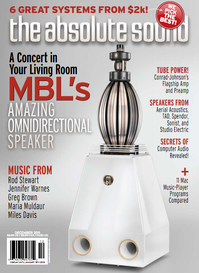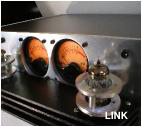|

EQUIPMENT REPORT
Studio Electric Monitor
By Steven Stone
Only a small percentage of us have the luxury of a room
dedicated exclusively to our sound systems. Most of
us must devise a way to share a multi-function living
room or family room with other members of our household.
In a perfect world these other family members wouldn’t have an
opinion about how speakers look. But since most mature adults,
regardless of gender, do have their own aesthetic sense, the way a
speaker looks can be a topic of heated domestic discussions.
Studio Electric understands the problems of sharing. Its Web
site proclaims “Industrial Art For Audiophiles,” and while Studio
Electric makes excellent-sounding and ridiculously reliable
amplifiers, its speakers are the stars here. Few pieces of audio
gear have as much industrial panache as the Studio Electric Type
One and Type Two speakers. Anyone who appreciates distinctive
industrial design will be impressed by the combination of Art
Deco visual audacity and solid audio engineering.
So stop for a second and look at the pictures of the Studio
Electric Monitors. Does this Craftsman/Arts and Crafts style
appeal to you? If the answer is yes and you’re looking for a speaker
for a small to mid-sized room, the Studio Electric Monitors may
fit you better than Cinderella’s glass slipper.
Not Flat and OK With That
The $2550-per-pair Studio Electric monitor is, as the name
strongly implies, a “monitor-sized” speaker. At 13.5 inches
high by 10.25 inches wide by 10 inches deep it is an averagesized
monitor. But where it begins to veer from the norm is its
sealed cabinet, which boasts a response curve of 47Hz to 20kHz
+/-3dB.
With a 1" silk dome tweeter and 6.5" copolymer long-stroke
midrange/woofer, the Studio Electric Monitor appears to be
a pretty standard mini, but looks can be deceiving. The two
drivers are melded with a unique asymmetrical crossover that
combines a 6dB-per-octave high-frequency roll-off for the
woofer with a 24dB-per-octave high-pass filter for the tweeter.
David MacPherson, Studio Electric’s president and principal
design engineer, told me, “The nominal crossover point is about
3.5kHz, but you are still getting 4kHz information from the 6.5"
speaker. The drivers sum in phase, but there is a small notch
around 3.5kHz because of the asymmetrical points and slopes. I
hate 3.5kHz anyway. . . what an aggravating frequency.”
Unlike some speaker designers, Mr. MacPherson doesn’t claim
to make a perfectly flat-measuring speaker. “I don’t like rulerflat
response in the 3.5kHz area, and if you pull a little out, the
speaker becomes less fatiguing and more musical. The human
ear is not a linear device anyway. I don’t know many people that
like the sound of a totally flat system, at least in those high-mid
frequencies, and particularly when things get loud.”
So while Mr. MacPherson isn’t averse to “voicing” the upper
midrange, he doesn’t augment the monitor’s bass. “Many small
monitors are voiced with a bump in the bass in the 70 to 100Hz
range to give the illusion of extended bass response. Well, it’s an
illusion, and it ends up resulting in one-note bass. We tried to
keep the bass response linear. I mixed a couple of CD projects
on the prototypes, and I found I could trust my mix more on
these than on monitors with a 70Hz bump.”
While the grille covers are removable, their look is integral
to the monitor’s overall visual presentation and many users will
probably want to use the speakers with them in place. I asked
McPherson about the metal grilles’ acoustic effects. “From an
esthetics standpoint, the world really didn’t need yet another
two-way speaker box. I decided on a different grille design,
to set the Monitor apart from other products.” MacPherson
chose a stainless-steel wire mesh that is used on microphones
because it’s acoustically neutral and it fits the 1930s Art Deco
aesthetic chosen for the cabinetry. According to MacPherson,
“The stainless mesh attenuates the tweeter just a bit, but it does
it evenly across the band, and not so much as to radically change
the voicing. I personally listen with the grilles on. Grilles off
gives just a smidge more tweeter.”
Looks Count
If you’ve read this far, obviously you like the Studio Electric
Monitor’s looks. The design also allows for a higher degree of
customization than your average monitor. MacPherson said, “We
do mostly black cabinetry with mahogany side panels and grille
frames. But we can also do them in piano black for the same
price. For an upcharge, you can have almost any exotic wood.”
My review samples used mahogany side panels, which reminded
me of the grain on the back of my 1936 Martin 000-18—nice,
straight, and tightly spaced.
Studio Electric recommends, and I concur, a slightly higher
stand than most monitors. Instead of a 24-inch-high stand, the
monitor needs a 28- or 30-inch stand, so that when you’re seated
the tweeter is slightly higher than your ear. On my desktop I also
raised the speakers four inches using two 500-sheet reams of 20-
pound OfficeMax multipurpose paper.
With only a single set of binding posts, the Studio Electric
Monitor doesn’t support bi-wiring, which saves the cost of an
extra run of speaker cable or high-quality jumpers. The Studio
Electric Monitor also has a sheet of rubberized material on its
base. This not only reduces slippage but also prevents the lacquer
finish on the bottom from getting scratched.
Sound Counts
One of my favorite intellectual games is to try for one sentence
that sums up an audio component. For the Studio Electric
Monitors this was rather easy: Imagine a Spendor SA1 with more
testicular fortitude. Regardless of the complexity of the music,
the Studio Electric Monitors remain unfazed by wide dynamics
and fast transients. Even at higher volume levels, where many
monitor-sized speakers begin to display signs of stress, the Studio
Electric Monitors remain completely unfazed. Like the Spendors,
the Studio Electrics never sound fatiguing, even after a day of
mid-to-high-volume listening. The Studio Electric Monitors’
“trick” is the higher crossover point, which allows the midrange/
woofer to handle more of the frequency range and dynamic
energy. While the tweeter is not a super-tweeter, it functions
more like one, because it fills in the upper frequencies while the
midrange/woofer does most of the heavy dynamic lifting.
If you set up the Studio Electric Monitors with your ears
below the tweeter and only slightly above the midrange/
woofer’s dust cap the monitors do a superb job of disappearing
on a desktop. Given their size, this is a remarkable feat. Other
similarly proportioned speakers, such as the Aerial Acoustics 5B,
don’t vanish quite as convincingly. The Studio Electric Monitors
also produce a large listening window that provides a stable and
cohesive stage. Moving from side to side or even rolling your
listening chair slightly back and forth won’t alter the image one
bit. Depth and dimensional cues are always easy to hear, and with
phase-coherent recordings the Monitors recreated an accurate
three-dimensional image where instruments had real presence.
Set up in a small room the Studio Electric Monitor simply
vanishes, which is what you’d expect from a speaker of its
dimensions. But where the Studio Electric Monitor excels over
many similarly sized speakers is its ability to produce the entire
size and scope of a symphonic soundstage. The Joseph Audio
Pulsars were the last stand-mounted speaker I had in my small
room that could generate such a complete and immersive image.
Usually, it takes larger floor-standers such as the Genesis 6.1 to
generate such a generous yet unsmeared view of the orchestra.
I mentioned earlier that the Studio Electric Monitors have
more bass extension than most similarly sized monitors, even
those with a port. Compared to the Aerial Acoustics 5B the
Studio Electric Monitors have noticeably more upper and
midbass energy. On my desktop I needed to move the Studio
Electric Monitors farther away from the front wall to reduce their
bass slightly. In my small room, where the speakers were well out
into the space, this added bass worked quite nicely to give music
more bloom and dynamic punch than with many other small
monitors I’ve had in the same spot. Blending the Studio Electric
Monitors with subwoofers, including the JL Audio Fathom f112
and Velodyne DD+ 10, was exceedingly easy since the Studio
Electrics lack any bass bumps and roll off smoothly.
The Studio Electric Monitors have a lovely and unfatiguing
midrange, not unlike the Harbeth P-3ES2 speakers. But unlike
the Harbeths, which compresses fff passages to f, Studio Electric
Monitors retains dynamic subtleties during louder passages.
With no hints of glare or grain at all reasonable listening levels
(at 110dB SPLs, all bets are off), the Studio Electric Monitors
remind me of what a mixing monitor should be—easy to listen
to critically while being gentle on your ears.
The one-inch silk dome tweeter delivers upper
frequencies without any artificial or metallic edge. For
listeners accustomed to hyped-up upper frequencies,
the Studio Electric Monitors may sound slightly
hooded or dark, but I think the silk dome sounds
more like music and less artificial than many more
esoterically-constructed tweeters. Its resolving abilities
are still first-rate despite the lack of extra upper
frequency edge or emphasis. It was easy to hear deep
into my own mixes of live concert recordings, as well
as some recent studio efforts with my bluegrass band,
where the Studio Electric Monitors made perfectly
clear that we are not yet ready for prime time.
In a room setup it’s vitally important that the Studio
Electric Monitors are placed on a taller-than-average
speaker stand. I used a pair of 24" Sound Anchor
single post stands augmented by the same two reams
of OfficeMax paper from my desktop to raise the
speaker platforms to 28". I used bright red bungee
cords to secure the speakers to the stands since I hate
the sound of speakers crashing to the floor.
If you try to use a short stand you will notice that the Studio
Electric Monitor’s tweeter has a noticeable roll-off if you are
more than about 30 degrees above the top of the speaker. When
I stood up while listening to applause and walked forward two
paces all the folks who clapped with open palms disappeared
as the treble attenuated. The good news here is if you have a
brighter than average room due to hard ceiling surfaces the Studio
Electric Monitor may fit better than other speakers with wider
vertical dispersion patterns because there’s less treble energy to
bounce off the ceiling. My longtime references, the Dunlavy SC
VI speakers were also purposely designed to reduce some of
their tweeters’ vertical dispersion for exactly this reason.
Last week the local community radio station, KGNU, broadcast
live sets from Colorado’s Rockygrass festival over its Internet
site. Their 128kbps stream sounded very good—so good that it
reminded me of the live FM broadcasts of the Boston Symphony
Orchestra from Symphony Hall that I used to listen to every
Friday afternoon. There’s a particular lack of micro-compression
when a live show is broadcast without any recording or playback
equipment in the signal path. The Studio Electric Monitors let
me hear this special “aliveness” quite clearly.
The Final Count
Since humans by their very nature are social creatures, inevitably
we must figure out successful ways to compromise in our
domestic environments. Sometimes that compromise revolves
around speakers—their size, shape, color, and location.
The Studio Electric Monitor was designed to not only fit into
multi-use rooms, but also look and sound good while doing it.
The owners of smaller mission or bungalow-style homes will
see the obvious stylistic influences from that particular design
aesthetic in the Studio Electric Monitor speakers. But even if
you’re not a Deco devotee, the performance of these $2550
speakers, especially as desktop monitors, makes them a savvy
option for anyone who wants to listen to music all day at high
volumes and still enjoy the experience well into the night.
|
|
|




